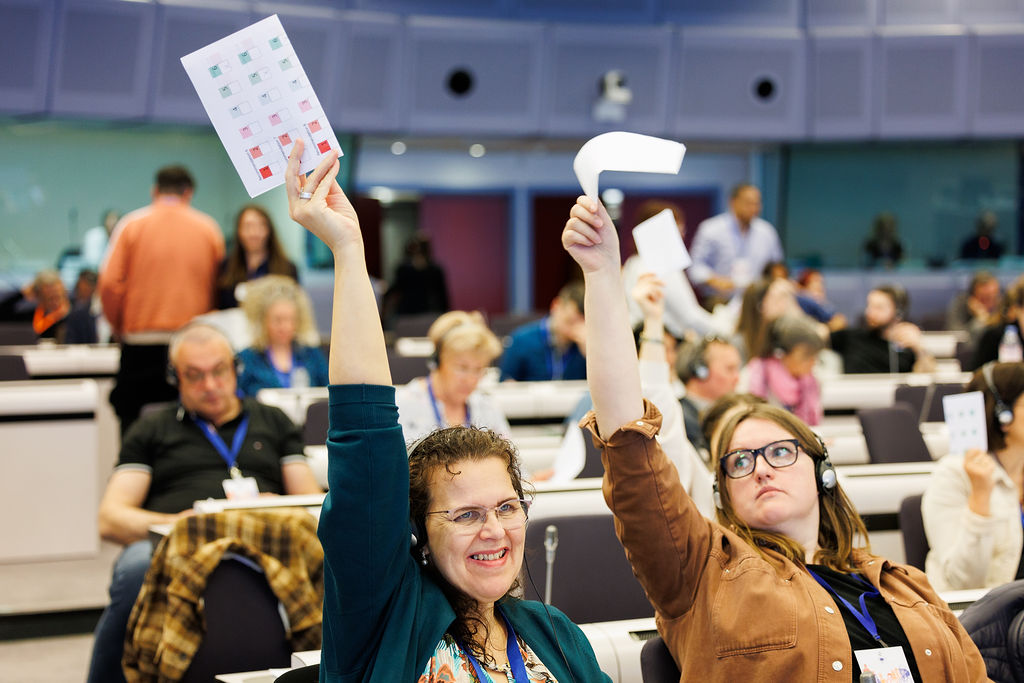People-powered Politics: the journey through Citizens' Panels
Together, tackling hatred in society
Over three weekends, 150 randomly selected EU citizens engaged in discussions on how to tackle hatred in society. The outcome: Despite a sensitive theme and a risk of strong emotions and divisions, panellists had a constructive and respectful debate. Want to discover how their very personal insights led them to create 21 concrete recommendations to the European Commission?
Watch it here!
Making better use of energy, together
The EU calls you. Do you pick up? When Csenge, Conall, and 148 other randomly selected EU citizens were called upon by the European Commission to discuss Energy Efficiency in Brussels, they took on the challenge. Want to see how their voices contributed to the debate?
Join their journey in the European Citizens’ Panel on Energy Efficiency.
The Citizens’ Panel on Tackling Hatred in Society has submitted its recommendations
Over three weekends, 150 randomly selected citizens representing all 27 EU Member States came together to discuss the various causes and drivers of hatred in the EU and different fields of action to address them.
Together, the citizens compiled a series of recommendations that will contribute to shaping future EU laws and feed into upcoming Commission initiatives.

What are European Citizens’ Panels?
They bring together randomly-selected citizens from all 27 member states to discuss – at European level – key, upcoming proposals that affect us all.
European Citizens’ Panels see participants working together in small groups (each of around 12 people) and all together (in plenaries). A facilitation team provides support. Based on the discussions, citizens make recommendations for the European Commission to consider when defining policies and initiatives.

How does a Citizens’ Panel work?
- Session 1Ideas generation
The goal of the first session is to generate ideas, and to build and group approaches that citizens find most promising for further discussion in subsequent sessions.
- Session 2Review and refinement
The goal of this session is to build on the approaches agreed in the first session and draft initial citizen recommendations. Following an iterative, 'peer review' process, citizens in working groups review and build on each other’s work, adding to the ideas. These constitute the basis for the panel to develop its final recommendations, during the concluding session.
- Closing sessionConclusion
The closing session submits the conclusions of debates, together with the panel's recommendations, to the European Commission, as part of the package accompanying the relevant proposals.
How are citizens selected?

Around 150 citizens, randomly selected from the 27 member states

Representing the EU’s diversity - geography (urban/rural), gender, age, education, socioeconomic background

1/3 of participants are young people (16-25 years old)
Participants of Citizens’ Panels are recruited through random selection. To ensure that panels reflect as far as possible the EU’s socio-demographic composition, the process ensures that recruitment is representative.
Target recruitment figures combine data from:
- Eurobarometer, the annual European Union public opinion survey, and
- Eurostat, the EU’s statistics office.
A quota system ensures a gender-balanced panel, and specifies that young people aged 16-25 represent a third of the panel. Other socio-demographic characteristics we take into account relate to:
- education level
- geographic location
- occupation.
Participants from each member state are recruited in proportion to that member state’s population, while ensuring proportional representation across different groups. For smaller countries with fewer participants, the categories are covered across panels, so that smaller countries are represented.
The selection process is completely renewed for each new panel.
Recruiting panels, which represent diversity are essential to facilitate vibrant discussions and ensure that those discussions reflect a wide variety of perspectives and opinions.
Concluded panels

How can the EU tackling hatred in society?

How can the EU bring benefits of energy efficiency to citizens, public authorities and enterprises?

How can we make opportunities for learning mobility a reality for everyone?

What vision, principles, and actions should guide the development of desirable and fair virtual worlds?

What actions should be taken by EU Member States, actors in the food supply chain, citizens, and other private and public stakeholders in order to step up the effort to reduce food waste?
Photo gallery


Tackling Hatred in Society Panel image 1Tackling Hatred in Society Panel image 1 

Tackling Hatred in Society HandoverTackling Hatred in Society Handover 

Tackling Hatred in Society Sub-plenary 1Tackling Hatred in Society Sub-plenary 1 

Panel on Energy Efficiency - recommendations handoverPanel on Energy Efficiency - recommendations handover 

Energy Efficiency Panel image 12Energy Efficiency Panel image 12 

Energy Efficiency Panel image 6Energy Efficiency Panel image 6 

Energy Efficiency Panel image 4Energy Efficiency Panel image 4 

Energy Efficiency Panel image 13Energy Efficiency Panel image 13 

Citizens' Panel on learning mobility - final group pictureCitizens' Panel on learning mobility - final group picture 

Learning mobility session 3 plenary presentationLearning mobility session 3 plenary presentation 

Learning mobility session 3 participant askingLearning mobility session 3 participant asking 

Learning mobility session 3 plenary votingLearning mobility session 3 plenary voting 

Learning mobility session 3 plenary groupLearning mobility session 3 plenary group 

Learning mobility session 3 plenary participantLearning mobility session 3 plenary participant 

Citizens' Panel on learning mobility - Session 3 ModerationCitizens' Panel on learning mobility - Session 3 Moderation 

Citizens' Panel on learning mobility - Session 3 openingCitizens' Panel on learning mobility - Session 3 opening 

Citizens' Panel on learning mobility - Session 3 participantCitizens' Panel on learning mobility - Session 3 participant 

Learning mobility session 3 plenary groupLearning mobility session 3 plenary group 

Citizens panel on virtual worlds - 3 group photoCitizens panel on virtual worlds - 3 group photo 

Citizens panel on virtual worlds - 3 working groupCitizens panel on virtual worlds - 3 working group




